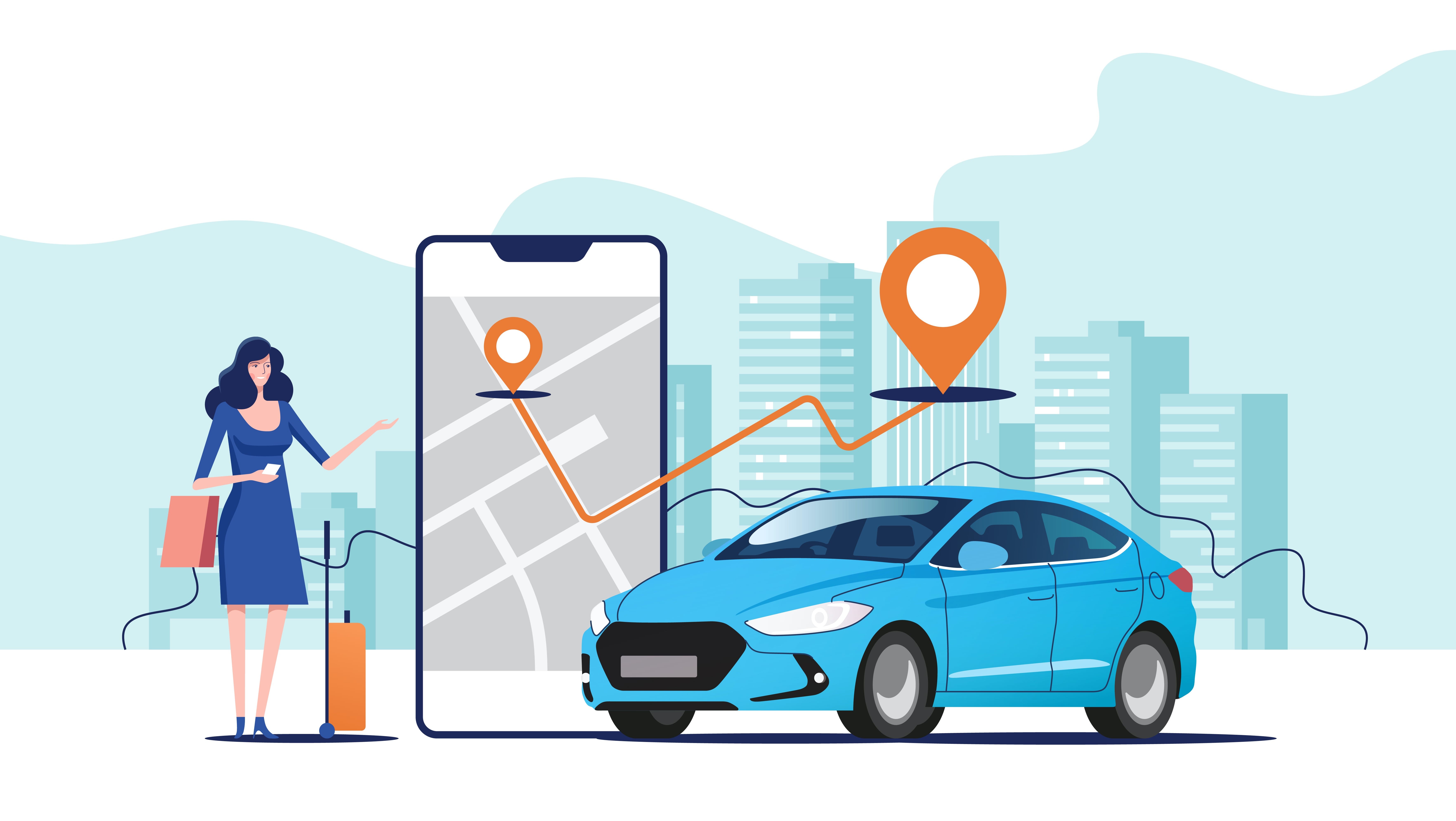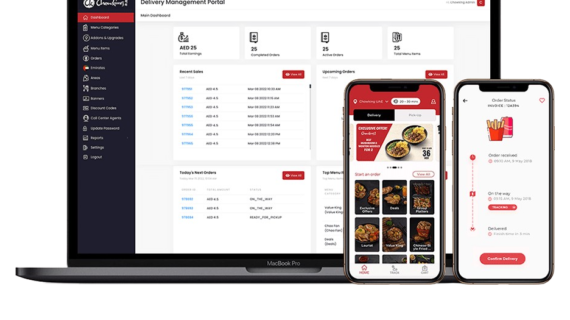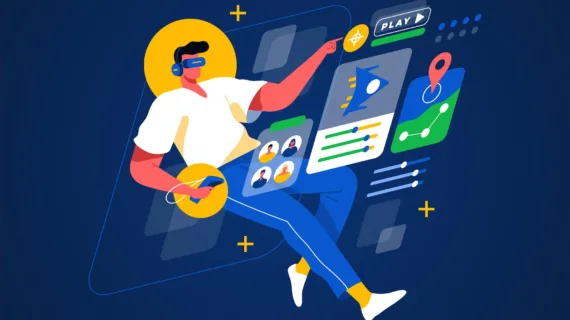
The ride-hailing segment is projected to reach US$260,159M in revenue in 2021. It is also expected to show an annual growth rate (CAGR 2021-2025) of 10.4%. Which will result in a projected market volume of US$385,942M by 2025. Additionally, the user penetration is at 19.6% in 2021 and is expected to reach 20.8% by 2025. In a nutshell, these stats indicate a shift in the way people are moving around places. The rising population continues to eat away the open spaces in urban cities. With worsening traffic conditions and parking spaces going full in no time, more and more car owners are turning to on-demand taxi services for convenient travel. In light of this scenario, and considering the rapid advancements in mobile app development. It’s fair to say that the future of the ride-hailing industry looks bright and promising.
Key Steps Involved in Uber-Like App Development Process
The development process of a taxi booking app can be broken down into 4 steps. Here’s what it looks like:
Technical Audit & Research
First off, you have to make a list of the requirements for your uber-like app development. If you have an existing taxi booking service, you’ll only need to build an app in line with your current operations. But if you’re starting from scratch, everything will need to be planned as per your vision. In both scenarios, business owners should take the opportunity to research and identify the improvements that they could offer over existing taxi booking apps.
App Documentation
Before moving on to app documentation, you’ll have decided the type of apps – native or hybrid and the platform for which they’ll be built – iOS and Android. These are questions of significant importance as they determine the absolute course of app development. Once these questions are answered and requirements have been finalized, the next step involves listing down the technical specifications of the app, the architecture, and the tech stack that would be used.
Building a taxi-booking mobile app
Development can be pursued either from scratch or using a ready-made solution. In either case, the project involves a series of operations divided into smaller individual tasks. These tasks are then completed based on their priority. Finally, further unit testing is performed throughout the process to identify & resolve any logical errors.
Deploying The App
Once developers build an app, they deploy it to live environments for functionality checks and performance testing on various devices. They quickly resolve any issues to prepare the app for a market launch.
So, those are the key stages of a taxi booking app development process. Now, to put things into perspective, it’s worth looking at how the pioneering on-demand ride-booking service Uber operates and how it’s been able to disrupt the taxi industry upside down.
Essential Features For Rider’s App
1. Geolocation and Routing
Geolocation is one of the most basic yet indispensable features in any taxi booking app like Uber. Much of the ride-booking process revolves around identifying the user’s exact location. GPS technology comes to the core for this functionality. While to the rider on the front-end, the process of dropping a pin on the map and finding the nearby drivers looks quite simple; there’s a complex amount of processing and data-sharing going on behind the scenes. From the moment the app is launched till the drop-off, a routing server works non-stop to measure the distance and run the routes.
2. Payment method Integration
Online payments have become the norm nowadays thanks to the advance in technologies. With Uber using cashless payments, this feature has come to be accepted as a standard in any taxi booking app. Uber offers its users a fare calculator that gives a decent estimate of the ride’s cost. This is based on the four main criteria:
- Base fare
- Cost per mile
- Cost per minute
- Safe rides fee
A payment method’s Integration should be performed with due care to ensure the user’s financial data safety. For example, for credit card data processing, the payment system should meet PCI compliance. Alternatively, you could opt for payment gateway providers that offer PCI compliance solutions like Braintree or Stripe.
3. Registration & Profile Management
User registration and profile setup are essential features in a taxi booking app as they allow you to get a real sense of your user base. In recent years, it’s become a common practice across all apps to enable user registration through Gmail or Facebook. In addition, the profile itself should allow for a basic identity setup(photo, name, phone number). Finally, users should be offered a rating/review system. This will enable you to gather crucial user insights, learn about their major pain points, and use that feedback to improve your service.
4. Communication & Notifications
The significance of timely communication can’t be emphasized enough in a taxi app like Uber. To make communication swift and hassle-free, Uber lets its users text/call each other without leaving the app. Still, to keep the driver and rider on the same wavelengths, the app sends out SMS, email, and push notifications during the critical stages of the ride-booking process. Push notifications on the iOS platform utilize Apple Push Notification Service, while the Android platform employs Firebase Cloud Messaging service. APIs like Twilio, Plivo, and Nexmo can integrate SMS notifications.
5. Ride Cost Estimate
This feature allows riders to get an estimated ride price based on the pick-up and drop-off locations. The calculation is worked out using an algorithm integrated inside the app. Different fares need to be specified if the platform offers a diverse range of vehicles for booking.
6. Schedule a Ride in Advance
Ride-scheduling is an advanced feature made famous by Uber a few years back. It allows users to book a ride in advance anywhere between 15 minutes to 30 days. This is a good feature for those who like to plan ahead of their travel. It could be part of the initial MVP release or rolled out in later updates based on user feedback.
Essential Features For Driver’s App
Driver Report
Driver report is an essential feature from the viewpoint of both driver and rider’s safety. The report provides brief information about the driver’s driving style and obedience to traffic rules over a week/month. The platform could ban a driver if it’s found that they continue to drive carelessly or are involved in several driving offenses.
Advanced Route Building
The feature of route building brings that cutting edge performance in a taxi booking mobile app. Moreover, it optimizes the routes that eventually contribute to the drivers’ efficiency. In the end, customers receive better service, which enables the app to increase in popularity.
Driver Destinations
To enhance the driver’s experience, the driver destination feature has become quite popular in taxi booking apps like Uber. As such, it should be considered as part of the app development. The feature allows drivers to select a favorite location and find passengers looking for a ride there.
Pro Tips To Gain a Competitive Edge In The Taxi Booking Industry
Features aside, there needs to be something extra that users should remember an app by. This makes even more sense in the online taxi booking industry, where new players continue to try their ideas to experience Uber-like success. The following are some of the strategies on which business owners can work to improve their chances of success.
1. Unique Value Proposition
It’s fair to say that there’s a direct correlation between an app’s success and end-user satisfaction. Based on that principle, the first thing that every cab-app service needs to tick off the box is riders’ and driver’s delight. There are numerous ways to offer unique value to both parties:
2. Consider Global Expansion
While starting small and locally is the preferred path, an exception can be made in the taxi-booking industry if your budget allows it. Uber’s success has proved the demand for the service is universal. Even countries where Uber faced opposition because its model was thought to be incongruent with domestic conditions have since welcomed the assistance.
What’s surprising, though, is that Uber still hasn’t covered every country on the globe. For instance, it’s not represented in Brunei, Malta, Iceland, Cyprus, and Luxembourg for different reasons. That’s evidence enough that the service has some roadblocks, and the first business to find a way across them can expect tremendous rewards.
How Much Does It Cost To Build a Mobile App Like Uber?
The cost to build a mobile app like Uber depends on several things. The price can differ even between two mobile app development companies in the same region based on their expertise and resources. Following are some of the most significant factors that impact the cost of development:
1. Features
There’s a direct correlation between a set of features and an app’s overall cost. As previously mentioned, an app can have many segments ranging from basic to some advanced ones. For example, the process of building a taxi-booking mobile app usually starts with an MVP. This includes both the passenger, rider, and admin apps but with bare minimum features.
Uber started much the same way. In its initial release, the Uber app lacked any gamification features and cost splitting. Instead, its primary objective is to connect drivers with passengers and offer a payment option within the app. Uber was able to achieve that with a good response.
The point about an MVP is that it helps ascertain idea feasibility and gather useful early adopter’s feedback. The same can then enhance product improvement by adding valuable features.
2. Business Type
Where a business currently stands has a significant say on the type of solution it would opt for. For instance, a company with an existing taxi booking service would like mobile apps developed in line with its internal operations. This will call for significant capital investment.
On the other hand, a startup taxi booking business would look to have a mobile app developed with limited functionality to support its short-term vision to gain traction. The development cost in this scenario will be much cheaper than the previous one.
3. Choice of Platform
Should I build for the stable iOS community or the ever-growing Android user base? The question never seems to get old for businesses with a limited budget to proceed with an MVP version on either platform and learn from user feedback. Uber initially developed for the iOS platform due to its popularity, especially in the Western world. If, however, you’ve got the budget for it, make the apps for both platforms as that will allow you to get broader coverage in any region.
4. Technology
Much like the platform, you have to decide about the technology to power your mobile apps. The choice comes down between Hybrid and Native. More often than not, people opt for native app development. A small percentage of business owners only select hybrid for a specific purpose. Both hybrid and native are different in terms of the programming languages and the architecture they use.
When discussing the cost of developing an app like uber, there’s no definite figure one can stick to. Statista provides the average rate for different locations around the world:
- North America — $60-250 per hour
- United Kingdom — $60-150 per hour
- Western Europe — $40-120 per hour
- Eastern Europe — $20-100 per hour
- India — $10-80 per hour
To emphasize the point, take these figures with a pinch of salt. They only reflect the averages. A comprehensive discussion about the project with a development partner can reveal additional costs.
Final Thoughts
Cab/taxi-booking giants like Uber and Lyft firmly hold their positions in the industry and aggressively pursue global expansion. However, there remains ample space for new players to innovate. By identifying a niche and focusing on the unique value proposition, they can create a profitable monetization strategy.
New players must always guard against feature creep, which is highly probable midway through custom app development.
DeviceBee Technologies makes application development more effortless than ever! We have expertise in developing every type of mobile app that is user-friendly and functional. Our apps have helped many businesses rise to great night; we are sure we can do it for you too!
So if you are looking for a capable technology partner for building on-demand apps for the transformation and logistics business, then you can Contact Us and get your free estimation or drop a query below. Read more about our products and services




Lorem ipsum dolor sit